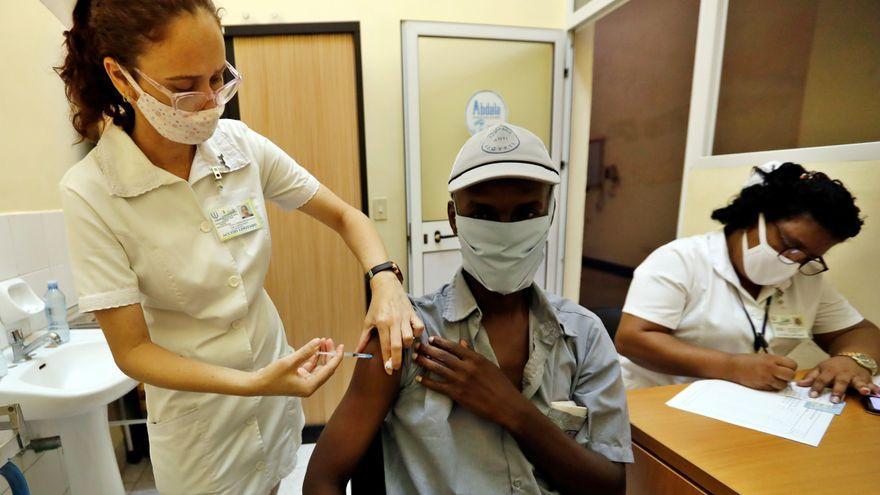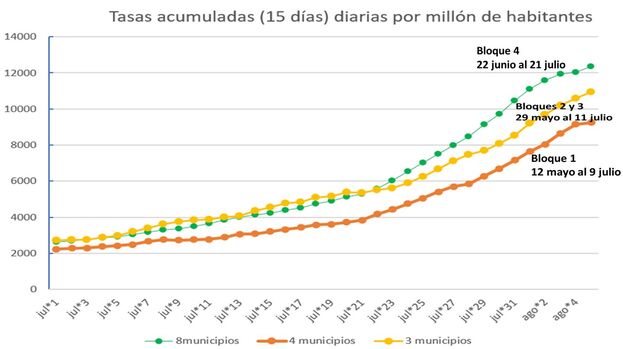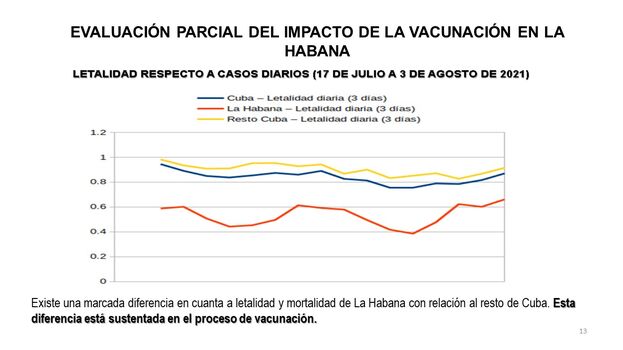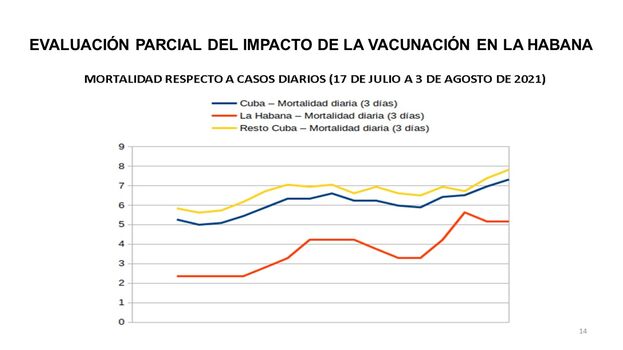
![]() 14ymedio, Havana, 11 August 2021 — Covid-19 indicators improve in Havana as immunization is completed. This is indicated by the data offered this Tuesday on television during the Roundtable program in which the authorities strove to make clear the effectiveness of the vaccines in a devastating context of widespread infections and mortality on the island.
14ymedio, Havana, 11 August 2021 — Covid-19 indicators improve in Havana as immunization is completed. This is indicated by the data offered this Tuesday on television during the Roundtable program in which the authorities strove to make clear the effectiveness of the vaccines in a devastating context of widespread infections and mortality on the island.
Despite an unclear presentation, the numbers show that the complete vaccination schedule with Abdala and Soberana 02 vaccines very slowly improves the outlook.
In the four municipalities of the capital that began immunization in May, the accumulated infection rate has visibly fallen compared to the 11 that began later. The authorities have segmented Havanans into three groups based on the start date of the vaccinations — May 12, May 29 and June 22. The rates are similar in the three groups at the beginning, but the lines begin to separate as the pattern is completed.

The authorities of the Ministry of Public Health and BioCubaFarma, present in the program, recalled that the immunity process is complete, when 14 days have passed since the last dose.
According to these figures, the fatality data also improves — the most relevant for the serum, called to lower the number of sick and deceased — but the data on infections are not the same, rather they are on the rise throughout the world as the Delta variant is spreading. Mortality rates (deaths in relation to the population) and fatality rates (deaths in relation to the percentage of positives) decrease. The first fell from 0.90 to 0.41 from June to July and mortality from 4.4 to 4.2.
“All these data are preliminary and we must continue working on them, but they are encouraging, because they are consistent,” said Pedro Mas Bermejo, vice president of the Cuban Society of Hygiene and Epidemiology, who insisted that the vaccines work.
The level of immunization in Havana is currently 63.8%, compared to the rest of the island, with 25.3%. Cuban experts insisted yesterday that the data provided was only an approximation and more details are needed. To this end, the Andariego-Higía program is being developed, prepared by GeoCuba with the collaboration of other institutions and with the database of the Ministry of Public Health, to detail the deceased, critical and seriously ill.
“It is a team effort, which allows us to search this database and know if a person is really vaccinated, and with how many doses, which offers consistency to these results.”

The officials went on television in the midst of a gloomy outlook for the Island and when the Pan American Health Organization (PAHO) was warning of the worrying situation. The intention was to clear up the doubts that have arisen with the vaccination program, which is progressing without perceiving a priori encouraging results.
Last week Ileana Morales Suárez, director of Science and Technological Innovation for the Ministry of Public Health, indicated that 72% of the positives in recent days have received the three doses of Abdala, and of them, 42% have already completed the total immunization cycle, “effective 15 days after injecting the last dose.” Although the figure is very high, the information provided yesterday indicates that there is an improvement, but the data remains to be fully analyzed and offered to the population.
The program focused on comparing the Cuban situation with the international one, where the Delta variant is also compromising the optimism of the first months of vaccination, as well as the population’s confidence in the sera.
That a resurgence is being experienced around the world is a fact, with a strain that is transmitted 1,200 times faster than the originals. Delta’s ease of spread has forced countries to recalculate group immunity, which was estimated at 70% and in recent days began to rise above 90%.
This Wednesday, the father of the Oxford vaccine, Andrew Pollard has insisted that the Delta variant makes it impossible to work with that idea and asks that vaccination programs are not based on achieving this objective because, once the strain is generalized, “it will continue to infect to people who have been vaccinated.”

The information available in most countries, which is offered in detail, by age group, prevalence of infection among those vaccinated and not, and so on, is making it possible to verify that transmission is much higher in unvaccinated age groups (many countries have immunized by population blocks from older to younger) and that severe cases occur mainly in these.
There is also evidence that the majority of those admitted are among those who refuse to be vaccinated, something that many governments try to put an end to through different techniques that range from stimulation to penalization, due to the collective risk that it entails.
Little is known about this level of detail in Cuba, despite the fact that the process continues to advance, and this lack of transparency prevents locating the problem and generating trust in the most suspicious population. “Currently, 29.4% of the Cuban population already has three doses administered. These figures are growing day by day in our country, at a vaccination rate almost double the world average, but there is still much to do,” recognize.
____________
COLLABORATE WITH OUR WORK: The 14ymedio team is committed to practicing serious journalism that reflects Cuba’s reality in all its depth. Thank you for joining us on this long journey. We invite you to continue supporting us by becoming a member of 14ymedio now. Together we can continue transforming journalism in Cuba.
